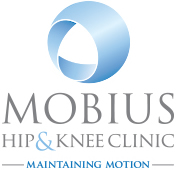
Total knee replacement
The knee is made up of the femur, the tibia, and the patella. The ends of these three bones, where they touch, are covered with articular cartilage, which protects the bones and enables them to move easily. The menisci are located between the femur and tibia. These C-shaped wedges act as "shock absorbers" that cushion the joint. Large ligaments hold the femur and tibia together and provide stability, and the long thigh muscles give the knee strength.
In knee arthritis (especially osteoarthritis), the cartilage in the knee joint gradually wears away. As the cartilage wears away, it becomes frayed and rough, and the protective space between the bones decreases.
People who benefit from total knee replacement often have:
- Severe knee pain or stiffness that limits everyday activities, including walking, climbing stairs, and getting in and out of chairs
- Moderate or severe knee pain while resting, either day or night
- Chronic knee inflammation and swelling that does not improve with rest or medications
- Knee deformity — a bowing in or out of the knee
- Failure to substantially improve with other treatments such as anti-inflammatory medications, cortisone injections, lubricating injections, physiotherapy, or other surgeries
There are no particular age or weight restrictions for total knee replacement surgery. Most patients who undergo total knee replacement are age 45 to 85, but we evaluate patients individually.
Total knee replacement is usually performed under general anaesthesia. There are four basic steps to a knee replacement procedure. These include:
- Prepare the bone: The damaged cartilage surfaces at the ends of the femur and tibia are removed along with a small amount of underlying bone.
- Position the metal implants: The removed cartilage and bone is replaced with metal components that recreate the surface of the joint. These metal parts may be cemented or press-fit into the bone.
- Resurface the patella: The under-surface of the patella is cut and resurfaced with a plastic button. In some cases, we don’t resurface the patella.
- Insert a spacer: A medical-grade plastic spacer is inserted between the metal components to create a smooth gliding surface.
The procedure itself takes approximately 1 to 2 hours. After surgery, you will be moved to the recovery room, where you will remain for several hours while your recovery from anaesthesia is monitored. After you wake up, you will be taken to your hospital room.
Possible Complications
The complication rate following total knee replacement is low. Serious complications, such as a knee joint infection, occur in fewer than 2% of patients. Major medical complications such as heart attack or stroke occur even less frequently. Infection may occur in the wound or deep around the prosthesis. This may occur while in the hospital, after you go home or even years later. Minor infections in the wound area are generally treated with antibiotics. Major or deep infections may require more surgery and removal of the prosthesis. Any infection in your body can spread to your joint replacement. Blood clots in the leg veins are one of the most common complications of knee replacement surgery. These clots can be life-threatening if they break free and travel to your lungs.
We will outline a prevention program, which may include periodic elevation of your legs, lower leg exercises to increase circulation, support stockings, and medication to thin your blood. After surgery, you may be prescribed one or more measures to prevent blood clots and decrease leg swelling. Foot and ankle movement is also encouraged immediately following surgery, to increase blood flow in your leg muscles to help prevent leg swelling and blood clots.
Despite the recent advances in implant designs/materials and surgical techniques, implant surfaces may wear down and the components may loosen. You will have stitches or staples running along your wound or a suture beneath your skin on the front of your knee. The stitches or staples will be removed 10-14 days after surgery. A suture beneath your skin will not require removal.
Exercise is a critical component of home care, particularly during the first few weeks after surgery. You should be able to resume most normal activities of daily living within 3 to 6 weeks following surgery. However, it is common to experience some pain during activity and at night several weeks after surgery. You will most likely be able to resume driving when your knee bends enough that you can enter and sit comfortably in your car, and when your muscle control provides adequate reaction time for braking and acceleration. Most people resume driving approximately 4 to 6 weeks after surgery.
Notify us immediately if you develop any of the following warning signs:
Warning signs of blood clots:
- Increasing pain in your calf
- Tenderness or redness above or below your knee
- New or increasing swelling in your calf, ankle, and foot
- Warning signs of pulmonary embolism
- Sudden shortness of breath
- Sudden onset of chest pain
- Localised chest pain with coughing
Warning signs of infection:
- Persistent fever
- Shaking chills
- Increasing redness, tenderness, or swelling of the knee wound
- Drainage from the knee wound
- Increasing knee pain with both activity and rest
Most people feel some numbness in the skin around your incision. You also may feel some stiffness, particularly with excessive bending activities. Most people also feel or hear some clicking of the metal and plastic with knee bending or walking. These differences often diminish with time and most patients find them to be tolerable, when compared with the pain and limited function they experienced prior to surgery.





